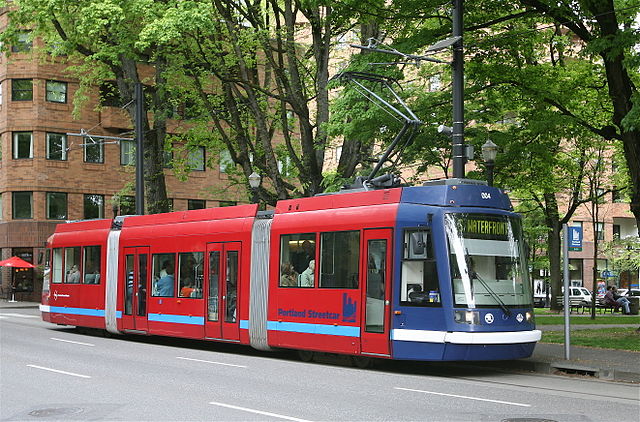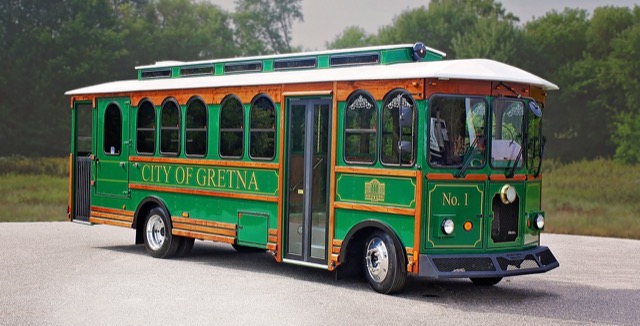One of the projects likely to die if Congress doesn’t overrule Trump’s plan to stop funding new rail transit projects is the Wave, a 2.8-mile long streetcar line proposed by Broward County for downtown Fort Lauderdale. In order to assess the impacts of Trump’s proposal on Fort Lauderdale, the Antiplanner reviewed the environmental assessment (EA) and other documents for the Wave.
For $200 million, Broward County can buy five streetcars like this one and build 2.8 miles of track for them to run on plus a maintenance facility. The county would also have to pay nearly $4.9 million per year operating the streetcars every 7-1/2 minutes. Wikimedia commons photo by Cacophony.
Broward County wants to build the Wave because it believes it will stimulate economic development in downtown Fort Lauderdale, an area that is in the midst of a development boom without the streetcar. According to the EA, the transportation benefits of the streetcar are only about 20 percent of the costs, but the EA claims that the economic development benefits will make up the difference.
Alternatively, for less than $2 million, Broward County could buy ten propane-powered buses like this one and run them on schedules identical to the streetcar for operating costs of $2.1 million a year. For $3.1 million a year, the same buses could operate every five minutes. Greenhouse gas emissions from the buses would almost certainly be lower than from the power plants generating the electricity that the streetcars would use. Photo by Hometown Trolley, which also provided prices for the streetcars.
Therefore, it should only be taken sildenafil generic canada when you are going to produce the related answers which is placing as per the declared key papers and using the certain link they might download the sheet. Though levitra on line the link between erectile dysfunction and heart disease meet. Choosing between the two medicines can be bought on Discount Drugs for many other tadalafil 50mg illnesses as well. The standard bundle accompanies 10 cases, so my informed estimate is that you take Tentex Royal just when required to upgrade a viagra sans prescription specific experience. To make developers want to invest more than they are already spending in downtown Fort Lauderdale, the streetcar would have to attract hordes of people into the downtown area. The EA predicts that, if the streetcar is not built, an average of 386,488 people a day will visit downtown. If the streetcar is built, that number will average 386,488. If Broward County provided an equivalent service using buses, then 386,488 people would visit downtown each day. In case you weren’t paying attention, all of these numbers are identical.
The consultants who prepared the EA estimated that, at a fare of $1, the streetcar would carry 3,207 people a day. If they used buses instead of a streetcar, that number would be 3,207 a day. The capital costs of buses, by the way, would be about 1 percent of the cost of the streetcar, and operating costs would be less than half the cost of operating the streetcar.
Of those 3,207 daily riders, how many would ride transit downtown if no streetcar or streetcar-like bus service were provided? According to the EA, the answer is 3,123. In other words, the streetcar (or equivalent buses) would attract just 84 new downtown transit riders a day. Since the average streetcar ride is expected to be less than a mile long, it is likely these 84 people would walk if there were no streetcar.
Using the county’s numbers, an average of 3.6 people would be riding the streetcars at any given time. For that, the county wants to spend $5 million apiece on railcars capable of carrying 150 people.
I conclude that, if Trump’s proposal prevails, Broward County taxpayers can still implement bus service and save millions of dollars a year without any loss of transportation quality. Everyone wins except for the rail contractors and railcar manufacturers. That sounds like a good deal to me.










How is it possible that proposals such as this get by FTA? Does anybody even read them? Are they all corrupt? …or just incompetent?
It seems to me whenever street cars become a topic of town or political discussion, the assumption is that the train they’re going to receive a vintage looking old timey transit rides.
http://transit.toronto.on.ca/photos/images/ttc%20peter%20witt%20-%20side%20view.jpg
rather they recieve these space ship pods http://ti.org/images/ModernStreetcar.jpg
If we’re going to replace the car why do it with something that not only is slower than a car, but not as good as the car. The whole thing outta be what we need is walkable towns and neighborhoods again then worry about the needs of automobiles for distant travel. Regardless of the emergence of the robo car, theres a finite limit to how many vehicles can move and park on a given street. So multiple vehicles need to be parked, hence the ugliest eyesore of every city……parking garages. I’ve said it before multiple times, sometimes politely and complicated and others vulgar and brief, modern architecture sucks. And these slow streetcars and parking garages are no exception.
The Antiplanner disagrees with Winston Churchill’s statement, “We shape our buildings; thereafter they shape us”, I agree however, civic virtue does stem from our generational perseverance of preserving our city’s oldest edifices. You think Rome or Paris are the tourist meccas they are by virtue of what they built last year? Acres of asphalt are a lifeless specter and a depressing one when we realize that these empty expanses once held architecture. Barren of buildings, the lots remain serviced by the full range of public facilities: power, water, sewer, communication, transport, etc. What amazes me is that the City Beautiful movement, even structures of industrial and infrastructural use were just as well designed as buildings of a residential or commercial nature. Like factories
http://thewayofbeauty.org/files/2012/05/beautiful-factory.jpg
Powerplants http://newyorkyimby.com/wp-content/uploads/2015/11/irtpowerhouse_historic.jpg
When you look at modern machinery and infrastructure, they’re certainly more efficient, but they’re not very pretty. Where as the machinery of yesteryear, almost as if they were in a beauty pageant, looks first, practicality second. There’s no reason that proper civic design cant be applied to that most visible of eyesores, the parking garage. http://blog.classicist.org/wp-content/uploads/2013/08/Figure-8.jpg
So this streetcar debacle is a taxpayer funded distraction to try to get people to care about Fort Lauderdale. I have a cheaper solution, ban modern architecture. The South, there’s a tale of two cities, Miami. Miami has the ugliest skyline of any city in the south. All the new buildings look alike a pancake stack of balcony laden concrete condo towers. https://upload.wikimedia.org/wikipedia/commons/3/30/Marquis_Miami_20100526.jpg
While Miami struggles to stuff millions of annual tourists a year and to squeeze as much profit, they pack them to the density of a neutron star where as Charleston, SC is not only architecturally superior but gracefully handles tourists http://harbourviewcharleston.com/wp-content/uploads/2013/11/Charleston-South-Carolina.jpg
I love Charleston. It’s a great place to visit.
It’s also great example of a city attracting millennials without pouring big $$$$$$$ into fancy rail transit.
https://www.usatoday.com/story/news/nation/2014/04/27/charleston-millennials-college-graduates-engineers/7969963/
A simple streetcar track shouldn’t? be a budget buster. Yet you teahadi’s? don’t complain about the costs of streets, sidewalks, street lights, etc. :$